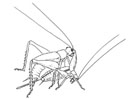|
Song at 25°C:
|
Where calling occurs (see below) it consists of sequences of 5 to 20 buzzy chirps at a rate of 1-2/sec. Courtship song sounds a bit like someone twirling a halloween noise maker.
|
|
Identification:
|
Length 9–14 mm. Short, compact crickets. Forewings covering more than two-thirds of abdomen (male forewings sometimes partially eaten away). Stridulatory file with fewer than 45 teeth, shorter than 0.85 mm.
|
|
Similar species:
|
Loud-singing bush crickets (Orocharis)—hindwings longer than forewings; length greater (15-22 mm).
|
|
Habitat:
|
Undergrowth in moist or wet wooded areas; roadside weeds.
|
|
Season:
|
Aug.–Nov. (Ind.), July–Dec. (n. Fla.), Mar.–Dec. (s. Fla.).
|
|
Remarks:
|
In peninsular Florida and eastern Texas, males of the restless bush cricket produce a loud distinctive song. Elsewhere they are not known to call. Little is known of how sexual pairs are formed in populations of non-calling crickets. Since non-calling restless bush crickets live in compact colonies, the males may simply roam about until they contact a female or are alerted to her presence by chemical cues. Once a female is located the male stays with her, sometimes producing soft courtship sounds with his forewings. If the female accepts a spermatophore from him, he puts his forewings to unique use by allowing the female to feed on them while the externally attached spermatophore is emptying into the female's sperm-storage sac. During one copulation a male may sacrifice a quarter of his forewings, and males are found that have nothing but stubs remaining. Copulating females of many other crickets feed on products of the male—for example, secretions from dorsal thoracic glands in tree crickets and blood from bleeding spines on the hind tibiae in ground crickets. Only in non-calling populations of restless bush crickets is the sexually successful male prominently mutilated. The nutritive value of the male's forewings and the consequences of a non-calling male averting mutilation are uninvestigated. The reproductive results of a male allowing a female to eat his forewings surely depend in part on whether the forewings can be used to call additional mating partners. Similarly the reproductive consequences for a female inseminated by a male that allows her to eat his forewings depend in part on whether her sons behave like their father.
|
|
Video:
|
A 30 minute video of mating behavior in H. agitator, courtesy of Wil Hershberger, is available here.
|
|
More information:
|
Subfamily Eneopterinae, genus Hapithus.
|
|
References:
|
Alexander & Otte 1967, Griffiths 1952a.
|
|
Nomenclature:
|
OSF (Orthoptera Species File Online).
|
























